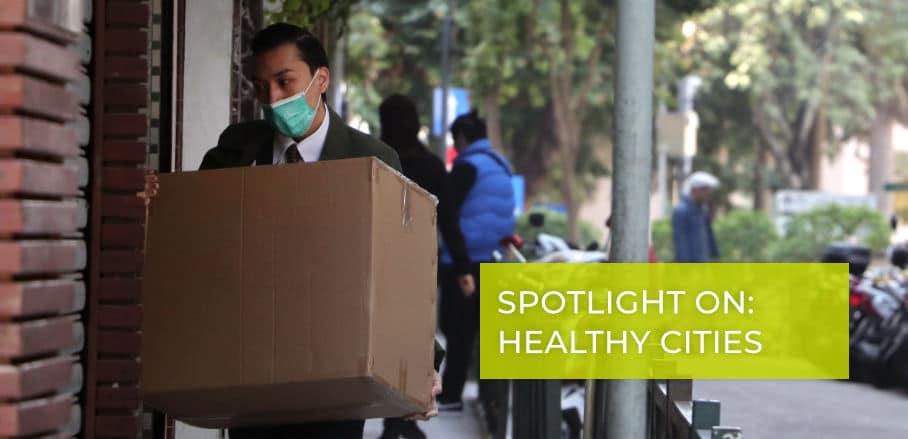Migrants Hold the Key to Urban Resilience and COVID-19 Recovery
Migrants are critical to the resilience of cities all over the world and simultaneously some of the most vulnerable urban dwellers when disaster strikes. Michele Acuto and Daniel Pejic from Connected Cities Lab explain why addressing urban migrant vulnerability strengthens the resilience of cities and fast-tracks our recovery from COVID-19.
Migrants are key to labour market flexibility, accounting, for instance, for 70% of the increase in the European workforce in the last decade. Immigrants working in high-income countries also provide millions of dollars of financial support to family members living in their country of origin. In fact, in 2015 alone, they contributed 432 billion US dollars to developing countries of origin – triple the amount (132 billion US dollars) accounted for globally as development aid.
Valuable but Vulnerable – Migrants in an Urban Age
Despite their positive impact, migrants are at the forefront of precarity, relying on formal and informal social support networks, both legal and not. They also contribute overall more in taxes than they actually receive in social benefits. Most live in low-income, precarious housing and healthcare situations – and yet, as the current crisis has clearly highlighted, they play a key part in some of society’s most essential services. Indeed, as the COVID-19 crisis continues to unfold, migrants have often been the silent and “unsung” heroes who keep cities going by occupying key roles in the healthcare, service, maintenance and logistics sector.
From cleaning, environmental services and maintenance, to the hospitality, delivery and logistics industries, and, of course, healthcare and education – migrants support the critical infrastructures the COVID-19 crisis response has been relying on; keeping in mind that many hold jobs where home office is not feasible or working remotely is simply not affordable.
On top of this, in cities like New York, Paris, Dubai or Bangkok, where migrants account for more than a third of the urban population, border closures are potentially catastrophic in economic as much as socio-cultural terms, as migrant workers remain stranded in a legal and financial limbo that few can afford. This impacts major employers across several sectors. In a number of countries, for example, border closures are jeopardising the higher education sector that is highly dependent on international students and foreign faculty staff.
Increased Awareness, Sustained Knowledge Gaps
The current situation calls indeed for a better understanding of the role of migrants in cities and their vulnerabilities in an increasingly unequal urban age. In this regard, there has been increased multilateral and international interest throughout the last decade. In 2015, the International Organization for Migration (IOM) themed its flagship report around the issue of “cities and migration”, calling for a better understanding and more effective partnerships to address these challenges. Likewise, in 2016, the third United Nations Conference on Housing and Sustainable Urban Development, or “Habitat III”, allowed some pivoting towards these efforts, as crystallised in IOM’s Migration Governance Framework, known as the “Migration Toolbox for Urban Governance”.
This framework provided a set of migrant-prioritised recommendations and operational guidelines to build and strengthen cities’ overall resilience to acute shocks as well as chronic stresses. Cities themselves have also taken to providing leadership and direct international action on this issue. A prime example of this is the “Mayors Migration Council”, a mayor-led initiative launched in 2018 by the Open Society Foundations to incorporate cities’ voices and interests in international deliberations on migration.
Even though this mounting interest has done a lot in terms of raising awareness about inequalities, we still know little about the impact of crises on urban migrants, and even less so about their potential to strengthen the long-term resilience of our cities. Frameworks are important, but we must build a robust evidence-base on the specific urban resilience dimension and develop tangible tools for local governments to effectively support urban migrants.
Taking the Lead – Opportunities for Local Government
This was, for instance, the ethos of a relatively confined effort in 2016 by the then-Rockefeller 100 Resilient Cities Network, now Global Resilient Cities Network, titled “Global Migration: Resilient Cities at the Forefront”. This work emphasised the need for cities to develop better local, national, and international partnerships to successfully integrate newcomers and build resilience.
Fundamentally, we must not only build resilience in migrant communities, but also consider migrants as central to urban resilience more generally. Local governments can take up a crucial leadership role and steer these efforts even ahead of their national governments, as they have already done in mobilising on the response to COVID-19 in many parts of the world.
At the heart of the future of global cities is not only understanding the challenges faced by migrants at the time of sudden disruptions – but also grasping the possibilities effective emergency responses can offer this diverse and vulnerable group. Inclusiveness is central here: this is not only about better economic resilience, but about how a clearer appreciation of the vulnerability of migrants can drive better urban life and more cosmopolitan cities for all. The time to begin these efforts is now, as we need not, and indeed cannot afford to wait until the resolution of the current global crisis.
